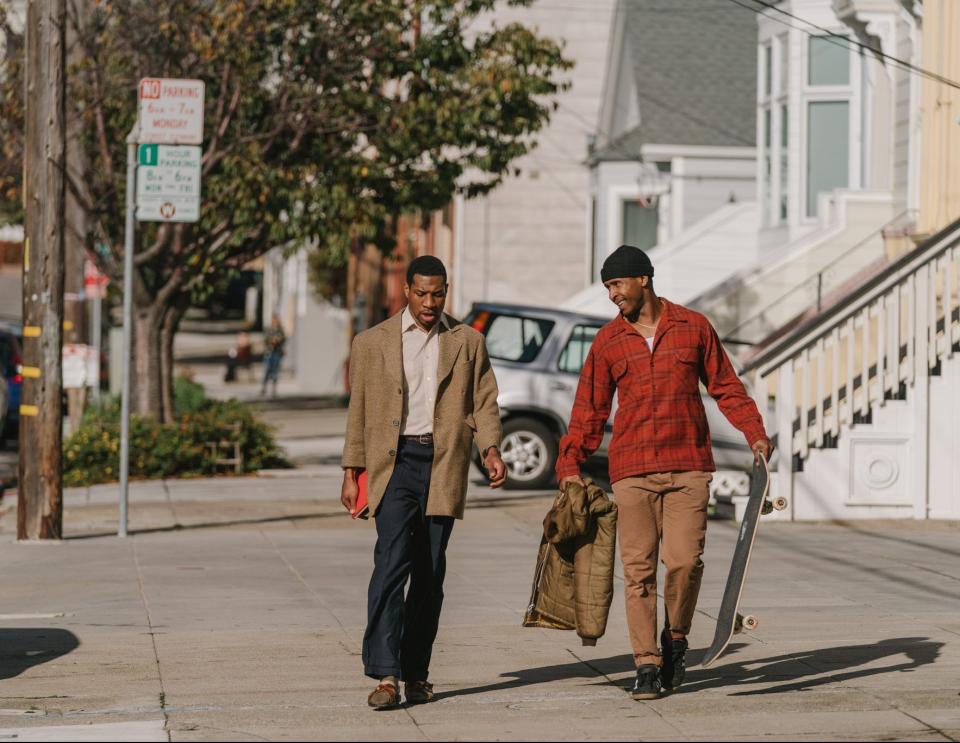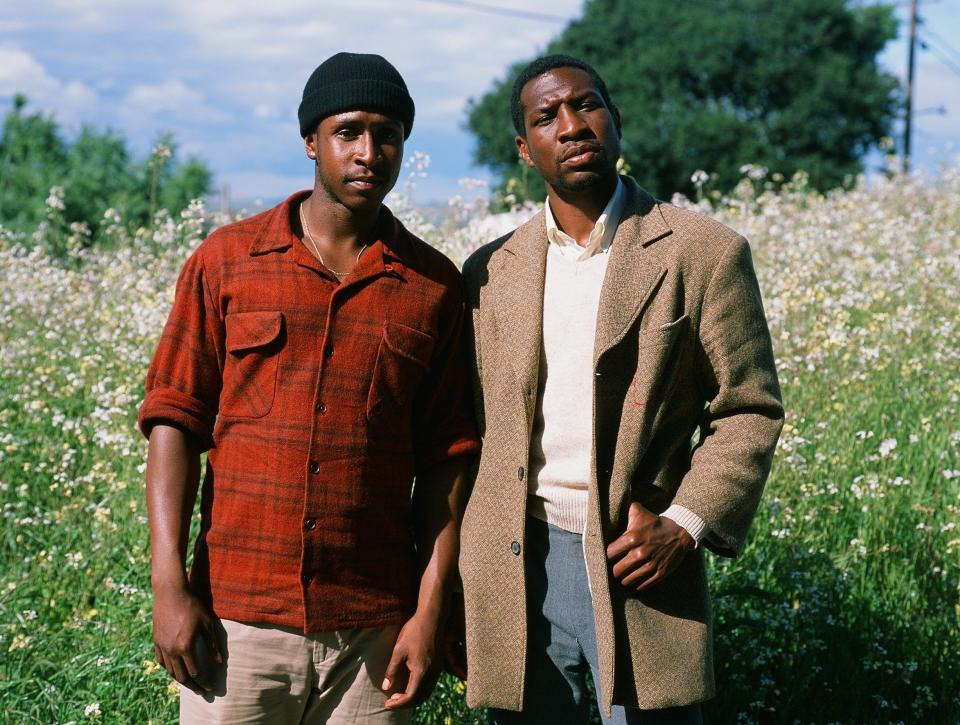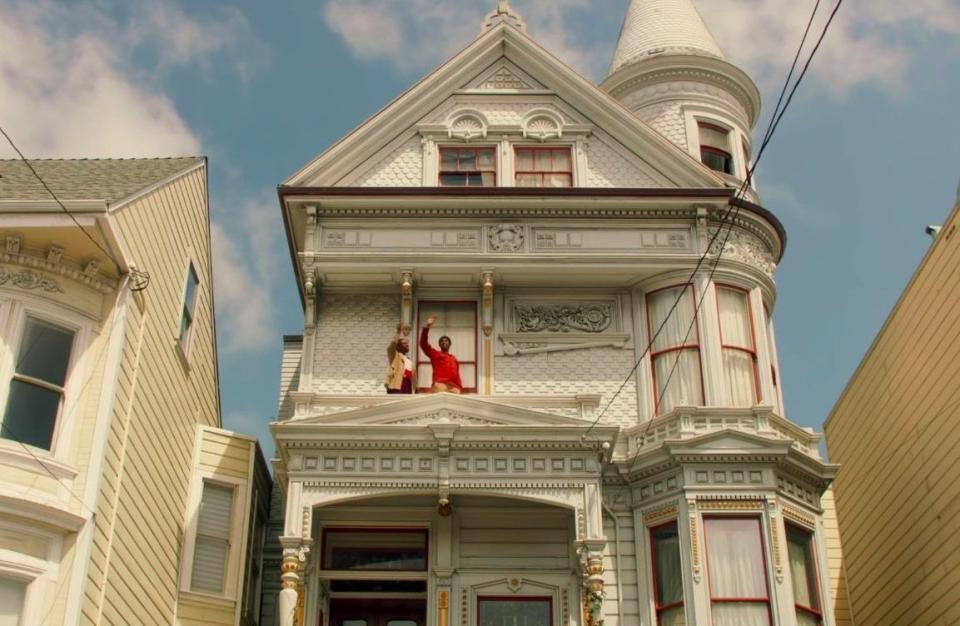Joe Talbot and Jimmie Fails on American Gentrification and The Last Black Man in San Francisco
(Editor’s Note: The following interview discusses some late-film plot details in The Last Black Man in San Francisco.)
At one point in director Joe Talbot‘s stunning film The Last Black Man in San Francisco, Jimmie Fails tells a pair of dismissive transplants aboard a city bus that “You don’t get to hate it unless you love it.” He’s talking about San Francisco, or at least the version of San Francisco in which he grew up. They hate the new city, the homogenized and hyper-gentrified city teeming with tech-boom money. Jimmie, meanwhile, is trying to hold onto the old San Francisco for as long as he possibly can.
For Talbot and Fails, who together devised the film’s story based on an amalgam of Fails’ own experiences with urban displacement and stories from their lifelong friendship, the San Francisco they knew is still there, underneath the perpetual construction and ever-rising rents. But it’s also endangered, and so The Last Black Man in San Francisco serves as much as a cultural document now as a resplendent drama.
The film follows two friends, Jimmie (Fails) and Mont (Jonathan Majors), who reclaim the lavish Victorian home in which Jimmie lived as a young man, until he and his father were priced out of the neighborhood. As they struggle with the realities of their situation, their place in a city looking to push them out, and the possibility that their San Francisco is slipping away, the film evokes singular feelings of mourning and loss.
Yet it’s also awash in a resigned, gritty kind of optimism, an understanding that the city will still reclaim a piece of itself as long as storytellers like Fails and Talbot are around to bang the drum. As the feature expands wider, the duo behind one of the most searing onscreen indictments of gentrification’s shattering effects to date sat down with Consequence of Sound to discuss translating their own stories, the soul of the house featured in the film, and more.
[youtube https://www.youtube.com/watch?v=C0FnJDhY9-0?version=3&rel=1&fs=1&autohide=2&showsearch=0&showinfo=1&iv_load_policy=1&wmode=transparent&w=806&h=454]
Gentrification is kind of rolling over every major American city to some end or another at this point. But even then, the Bay Area has become this particular exemplar of it, and of how bad it can get. What about the Bay Area experience of it did you want to capture in particular when putting the film together?
Jimmie Fails: Well, even more specifically San Francisco, because yes. All the movies coming out about gentrification are in Oakland, and you know, as much as a lot of it’s for the same reasons, it’s just a different city. It’s a different history and it’s a different city. Also, I don’t think that gentrification is happening as rapidly there as it is in San Francisco. So that’s what we really wanted to touch on, was how fast it’s happening. Because even when we were shooting the movie, [we’d be] at a location and then after we’re done filming there, it’s changed already by the time we’d come back. You know, I was saying yesterday that in a way, our movie’s a period piece already. And it was only filmed a year ago.
Joe Talbot: Yeah. Another one closed too. The SRO [Single Room Occupancy] where Jimmie’s dad’s scene is, where he’s in the window, that’s closed. The projects where the candy house is, all bulldozed. There’s someone from our local paper who was chasing around, trying to find locations, calling us like, “where is this? I can’t find this place.” It was like, it doesn’t exist anymore. So there’s that feeling, like you’re chasing ghosts in San Francisco.
Going now, traveling with the movie to more cities than I’ve ever traveled to in my life, I’m talking to people, hearing stories that basically regional culture is being destroyed. Everywhere you go has avocado toast and Acai bowls, but there used to be regional accents and architecture that defined areas, and things very specific to the culture of the people that have been there for a long time. And it feels like now we’re going through this period. It feels like the loss of that.
JF: You don’t even hear young people, like coming up, saying slang that’s specific to San Francisco anymore. You only get that from the older people. It’s weird. It’s little stuff like that, you know?
JT: There was a feeling growing up in San Francisco. There was the park where we met as kids, Precida Park, you’d see Filipino kids, Samoan, Latino, black, white. All hanging around each other, getting to know each other and dating across different backgrounds. And I think that San Francisco, I’m afraid, is on the verge of not existing, because so many of the people that we grew up with are being priced out of the city. And out of that sort of crossover, you have friendships like ours. So for one, I fear that the next generation won’t be making art like this. ‘Cause those friendships have to take form to produce that art.
But also, it changes your whole life to grow up around different kinds of people, and so it’s a strange time. The movie’s out in San Francisco, and it’s having a big impact, it seems, in some ways on the city. [Teenagers] were telling us how inspired they are and how they want to go make their films now. So that gives me hope. It’s encouraging, because in the face of all of this struggle, it can feel sometimes insurmountable. They’re these teenagers who know that we came up together, and then a group of friends of ours came up together making this, and they want to do the same thing. So there is hope.
The Last Black Man in San Francisco (A24)
How do you retain that spirit of the city within yourselves, or inspire it in other people, when it seems like everything about San Francisco right now is trying to break that down?
JF: I think it’s kind of instilled in you as a San Franciscan, and as an artist, [that] you’re not going to give up that easy. So however you can. We made this movie, that’s our way of fighting back. Or at least, I don’t even want to say “fighting back” to make it seem that we’re fighting, but we do want to archive what it was, so that you can educate gentrifiers. You know, so that they know who was there before. So I think Jimmie’s spirit in the film, he holds in his character the spirit of San Francisco, of people that have been there, while in some ways it feels like fighting to stay against these odds. [He’s not] willing to give up on the city that they love, even if it feels like it doesn’t love him back.
And I think that’s part of what we’re seeing, surprisingly. I think we felt like we wanted to get all the little details of the city. You asked about sort of capturing the spirit of the city. It’s everything from seeing couples like Wanda and Ricky, Jimmie’s aunt played by Tichina [Arnold] and Daewon Song, this woman with this hot skater boyfriend, to passing a naked man on the street. Those are some of the things that feel integral to San Francisco in their own small ways. We wanted to make sure that there was no throwaway role, or throwaway scene, even if it was just a line. Everything down to the Muni bus. We used a Muni bus from old San Francisco that I think a lot of people that grew up there have a certain nostalgia for.
But what’s surprising is how many people don’t pick up on all those little intricacies and nuances in other cities, [who] are having a similar reaction to the San Franciscans when they see this movie. A lot of people are coming up to us and saying, “Wow, I feel myself in this film. I got turned out of my home.” Last night, we screened it in Evanston, and I felt like we were in San Francisco talking to people afterwards. It’s both warming to see how a story that’s so specific can spread to different places and hold resonance there, and also a little bit horrifying because it means that the same things are happening here.
The Last Black Man in San Francisco (A24)
In taking this story that’s at once so intensely personal and singular in some ways, but telling it in a way where someone outside the city can attach to it, how did you go about trying to find that balance of when it needed to be as personal as possible, or when creative license was in order?
JT: We’ve been making movies since we were teens, and they always come from some kernel of truth, some real story that happened to him or I, and then they always sort of like get spun into whatever they become through our imagination collectively. So this one didn’t feel that different. There are scenes that are pulled very much from Jimmie’s life, but it was never a question of, “Oh, this one should feel more real than this.” Jimmie often says this, they’re emotionally real in some ways. So for us, I think it was always just trying to take what was so interesting and specific about the moment when we first discussed it, or when we first experienced it, and trying to find a way to communicate that through the film.
For instance, there was a guy who drove off with the car that Jimmie was in with his dad as a kid. But then in that particular instance, it took a humorous turn in our conversation and made us think about who would be great at being in denial about that very idea, that he had stolen your car. You know, in his eyes, he just borrowed it. And I was like, well, Mike Epps is perfect for that. So then it grew from just thinking about how Jimmie, who’s so good in those comedic situations as the straight, could play off Mike Epps, who won’t acknowledge this thing, but in his own way is offering this other bit of philosophy that Jimmie might not be thinking about, which is “why are you chasing home?”
And Mike, I loved what he said to me. When I first talked to him, it was on FaceTime and he was getting a haircut. So he’s with his barber, and I’m FaceTiming Mike Epps, I’m kind of geeking out. And he’s like, “You know, Bobby’s unstoppable. Bobby doesn’t want shit. Everyone else in San Francisco is chasing something. Techies, Jimmie, everyone is chasing something. And I’ve beat the system, I’ve beat the city cause I don’t want anything.” And I think that’s sort of his ethos in that scene. And of course Jimmie does want something. He wants the city back, and he wants that house.
The Last Black Man in San Francisco (A24)
In terms of the house itself, you’ve both discussed before how it’s not the house, the real-life one. In terms of finding what was going to be the house in the film, how did you land upon that one in particular?
JF: It took us a while to find the house, because that was the only one that felt like the owner actually had respect [for it] and spent his whole life restoring the details of the old-style Victorian, as opposed to going to a Victorian house that has a facade, knocking on the door, walking in and it’s like you’re in IKEA. That was the only one that felt like … it was a love at first sight sort of thing. You walk in and you don’t even feel like you’re in modern-day San Francisco. It took a while, but as soon as we walked in, it was just like a feeling came over, and I think that comes through in the film. The house is a character, in and of itself. And it feels like it has a soul.
The way the city’s visualized throughout the film, there are times where it’s a colossal expanse, and others where it feels way more compact. What was the process of figuring out how you wanted the city to look, and what diversity of looks you wanted to get out of it?
JT: I completely agree with what [Jimmie] said about it feeling almost like a period piece. That applied to when we were scouting locations as well, not just the final result, because we were trying to find places that captured old San Francisco. And so in some ways, the city doesn’t wholly look like our film. There are parts of it that certainly do, but right outside the frame in some sequences are places that we weren’t as interested in highlighting. I think the contrast of old and new was something that was within the story, but it was important that we show it in the right moments. So you fall in love with Jimmie’s San Francisco. Hopefully.
In that opening sequence, his skating through the city, you’re feeling the world and people and buildings and the things that we love. And we tried to hold off on new San Francisco until the very end, when Mont comes back inside the house. And as Jimmie said, it feels like it’s been IKEAed. I think when you’ve been in this world, immersed in the San Francisco that we were immersed in as kids, you understand then how jarring it feels to see that world with the CB2 furniture and the white walls and the open floor plan. It’s hard if you see that from the onset, because that’s what we all see every day. But to kind of go almost back in time with us and then be hit by the harsh reality, [that] was important to what we wanted to show.
The Last Black Man in San Francisco is playing now in select cities, with a wider release to follow on June 21st.
Joe Talbot and Jimmie Fails on American Gentrification and The Last Black Man in San Francisco
dsuzannemayer




